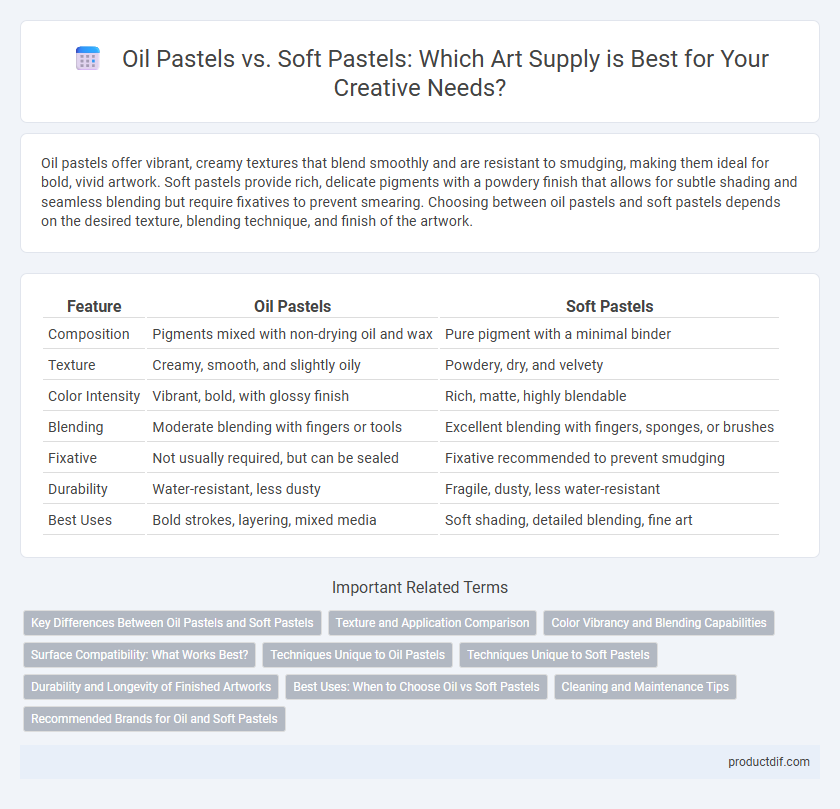Oil pastels offer vibrant, creamy textures that blend smoothly and are resistant to smudging, making them ideal for bold, vivid artwork. Soft pastels provide rich, delicate pigments with a powdery finish that allows for subtle shading and seamless blending but require fixatives to prevent smearing. Choosing between oil pastels and soft pastels depends on the desired texture, blending technique, and finish of the artwork.
Table of Comparison
| Feature | Oil Pastels | Soft Pastels |
|---|---|---|
| Composition | Pigments mixed with non-drying oil and wax | Pure pigment with a minimal binder |
| Texture | Creamy, smooth, and slightly oily | Powdery, dry, and velvety |
| Color Intensity | Vibrant, bold, with glossy finish | Rich, matte, highly blendable |
| Blending | Moderate blending with fingers or tools | Excellent blending with fingers, sponges, or brushes |
| Fixative | Not usually required, but can be sealed | Fixative recommended to prevent smudging |
| Durability | Water-resistant, less dusty | Fragile, dusty, less water-resistant |
| Best Uses | Bold strokes, layering, mixed media | Soft shading, detailed blending, fine art |
Key Differences Between Oil Pastels and Soft Pastels
Oil pastels consist of pigment mixed with a non-drying oil and wax binder, offering vibrant colors with a creamy, blendable texture that resists smudging once applied. Soft pastels are made from pure pigment combined with a minimal binder, resulting in a powdery texture that allows for smooth blending and rich, matte finishes but tends to produce more dust and require fixatives. The primary differences lie in their composition, application techniques, drying properties, and the type of surfaces best suited for each medium.
Texture and Application Comparison
Oil pastels offer a creamy, smooth texture that allows for vibrant, easily blendable color application, making them ideal for layering and creating rich, thick strokes. In contrast, soft pastels provide a velvety, powdery texture that produces delicate, matte finishes and effortless blending but can be more fragile and prone to smudging. Artists often choose oil pastels for bold, textured effects, while soft pastels excel in subtle tonal gradients and fine detail work.
Color Vibrancy and Blending Capabilities
Oil pastels offer intense color vibrancy with a creamy texture that allows for smooth, bold application, ideal for achieving bright, saturated artwork. Soft pastels provide superior blending capabilities due to their powdery consistency, enabling artists to create subtle gradients and seamless transitions in color. Both mediums excel in vibrancy, but oil pastels maintain thicker, more vivid layers while soft pastels are preferred for delicate blending and layering effects.
Surface Compatibility: What Works Best?
Oil pastels perform best on textured surfaces like canvas, wood, and pastel paper, as their oily consistency adheres well and maintains vibrant colors. Soft pastels require toothy surfaces such as sanded pastel paper or textured boards to hold their powdery pigment effectively and prevent smudging. Selecting the appropriate surface enhances color richness and durability, maximizing the unique qualities of each pastel type.
Techniques Unique to Oil Pastels
Oil pastels offer vibrant, creamy textures that blend smoothly with finger smudging and layering techniques unique to their waxy consistency. Unlike soft pastels, oil pastels can be sgraffitoed, a technique involving scratching through layers to reveal underlying colors for detailed effects. Their ability to adhere to varied surfaces like canvas and paper expands creative possibilities beyond the delicate application methods typical of soft pastels.
Techniques Unique to Soft Pastels
Soft pastels require specialized techniques such as layering and blending directly on the surface to achieve vibrant color transitions and rich textures. Their powdery, delicate nature allows for smudging and feathering effects that are difficult to replicate with oil pastels. Mastering fixatives is essential to preserve soft pastel artwork and prevent smudging during or after the creative process.
Durability and Longevity of Finished Artworks
Oil pastels exhibit exceptional durability due to their waxy base, which resists cracking and fading over time, ensuring vibrant colors in finished artworks. Soft pastels, composed of powdered pigment and minimal binder, offer rich, blendable textures but require fixatives to maintain longevity and prevent smudging. Proper sealing and framing enhance the preservation of both oil and soft pastel artworks, extending their lifespan significantly.
Best Uses: When to Choose Oil vs Soft Pastels
Oil pastels are best for vibrant, creamy textures and blending on non-porous surfaces, making them ideal for bold, expressive artwork and mixed media projects. Soft pastels offer rich, velvety pigments that blend smoothly on textured paper, perfect for detailed, layered portraits and landscapes with subtle color transitions. Choose oil pastels for durability and bright, glossy finishes, while soft pastels excel in fine detail and depth on traditional pastel paper.
Cleaning and Maintenance Tips
Oil pastels require minimal cleaning since they are less dusty and can be wiped off surfaces with a damp cloth, while soft pastels produce significant dust that necessitates regular cleaning of workspaces and ventilation to avoid respiratory issues. To maintain oil pastels, avoid exposing them to heat and store them in airtight containers to prevent drying and deformation, whereas soft pastels benefit from protective cases and gentle handling to prevent breakage and powder loss. Both types of pastels should be kept away from direct sunlight and moisture to preserve their color integrity and longevity.
Recommended Brands for Oil and Soft Pastels
Sennelier and Unison are top recommended brands for oil pastels, known for their vibrant pigmentation and smooth application, ideal for professional artists. For soft pastels, Schmincke and Rembrandt offer superior quality with rich, blendable colors favored in fine art. Both categories benefit from brands that emphasize lightfastness and texture, ensuring durability and creative flexibility.
Oil Pastels vs Soft Pastels Infographic

 productdif.com
productdif.com